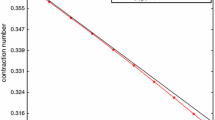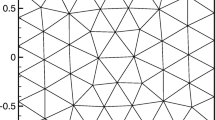Abstract
We propose a new dimension-wise splitting with selective relaxation (DSSR) method for saddle point systems arising from the discretization of the incompressible Navier–Stokes equations. Using Fourier analysis, we determine the optimal choice of the relaxation parameter that leads to the best performance of the iterative method for the Stokes and the steady Oseen equations. We also explore numerically the influence of boundary conditions on the optimal choice of the parameter, the use of inner and outer iterations, and the performance for a lid driven cavity flow.









Similar content being viewed by others
Notes
2.0439 is a root of the polynomial \(12x^4-36x^3+11x^2+23x+5\).
We thank an anonymous referee for pointing out that in the Stokes case, \(\nu \) could actually be scaled out of the problem.
References
Bai, Z.-Z.: Optimal parameters in the HSS-like methods for saddle-point problems. Numer. Linear Algebra Appl. 16(6), 447–479 (2009)
Bai, Z.-Z., Golub, G.H.: Accelerated Hermitian and skew-Hermitian splitting iteration methods for saddle-point problems. IMA J. Numer. Anal. 27(1), 1–23 (2007)
Bai, Z.-Z., Golub, G.H., Li, C.-K.: Optimal parameter in Hermitian and skew-Hermitian splitting method for certain two-by-two block matrices. SIAM J. Sci. Comput. 28(2), 583–603 (2006)
Bai, Z.-Z., Golub, G.H., Li, C.-K.: Convergence properties of preconditioned Hermitian and skew-Hermitian splitting methods for non-Hermitian positive semidefinite matrices. Math. Comp. 76(257), 287–298 (2007)
Bai, Z.-Z., Golub, G.H., Ng, M.K.: Hermitian and skew-Hermitian splitting methods for non-Hermitian positive definite linear systems. SIAM J. Matrix Anal. Appl. 24(3), 603–626 (2003)
Bai, Z.-Z., Golub, G.H., Pan, J.-Y.: Preconditioned Hermitian and skew-Hermitian splitting methods for non-Hermitian positive semidefinite linear systems. Numer. Math. 98(1), 1–32 (2004)
Bennequin, D., Gander, M.J., Halpern, L.: A homographic best approximation problem with application to optimized Schwarz waveform relaxation. Math. Comp. 78(265), 185–223 (2009)
Bennequin, D., Gander, M.J., Gouarin, L., Halpern, L.: Optimized Schwarz waveform relaxation for advection reaction diffusion equations in two dimensions. Numer. Math. (2016) (to appear)
Benzi, M., Gander, M.J., Golub, G.H.: Optimization of the Hermitian and skew-Hermitian splitting iteration for saddle-point problems. BIT 43(5), 881–900 (2003)
Benzi, M., Golub, G.H., Liesen, J.: Numerical solution of saddle point problems. Acta Numer. 14(1), 1–137 (2005)
Benzi, M., Guo, X.-P.: A dimensional split preconditioner for Stokes and linearized Navier–Stokes equations. Appl. Numer. Math. 61(1), 66–76 (2011)
Benzi, M., Ng, M.K., Niu, Q., Wang, Z.: A relaxed dimensional factorization preconditioner for the incompressible Navier–Stokes equations. J. Comput. Phys. 230(16), 6185–6202 (2011)
Brown, P.N., Walker, H.F.: GMRES on (nearly) singular systems. SIAM J. Matrix Anal. Appl. 18(1), 37–51 (1997)
Cao, Y., Du, J., Niu, Q.: Shift-splitting preconditioners for saddle point problems. J. Comput. Appl. Math. 272, 239–250 (2014)
Elman, H.C., Howle, V.E., Shadid, J., Shuttleworth, R., Tuminaro, R.S.: Block preconditioners based on approximate commutators. SIAM J. Sci. Comput. 27(5), 1651–1668 (2006)
Elman, H.C., Howle, V.E., Shadid, J., Silvester, D.J., Tuminaro, R.S.: Least squares preconditioners for stabilized discretizations of the Navier–Stokes equations. SIAM J. Sci. Comput. 30(1), 290–311 (2007)
Elman, H.C., Tuminaro, R.S.: Boundary conditions in approximate commutator preconditioners for the Navier–Stokes equations. Electron. Trans. Numer. Anal. 35, 257–280 (2009)
Gander, M.J.: Optimized Schwarz methods. SIAM J. Numer. Anal. 44(2), 699–731 (2006)
Gander, M.J.: Schwarz methods over the course of time. ETNA 31, 228–255 (2008)
Gander, M.J., Halpern, L.: Optimized Schwarz waveform relaxation for advection reaction diffusion problems. SIAM J. Numer. Anal. 45(2), 666–697 (2007)
Gander, M.J., Xu, Y.: Optimized Schwarz methods for circular domain decompositions with overlap. SIAM J. Numer. Anal. 52(4), 1981–2004 (2014)
Gander, M.J., Xu, Y.: Optimized Schwarz methods with nonoverlapping circular domain decomposition. Math. Comp. (2016) (to appear 2016)
Harlow, F.H., Welch, J.E.: Numerical calculation of time-dependent viscous incompressible flow of fluid with free surface. Phys. Fluids 8(12), 2182–2189 (1965)
Lebedev, V.I.: Difference analogues of orthogonal decompositions, basic differential operators and some boundary problems of mathematical physics. I. USSR Comput. Math. Math. Phys. 4(3), 69–92 (1964)
Reichel, L., Ye, Q.: Breakdown-free GMRES for singular systems. SIAM J. Matrix Anal. Appl. 26(4), 1001–1021 (2005)
Saad, Y.: Iterative Methods for Sparse Linear Systems, SIAM (2003)
Welch, J.E., Harlow, F.H., Shannon, J.P., Daly, B.J.: The MAC method-a computing technique for solving viscous, incompressible, transient fluid-flow problems involving free surfaces. Tech. Rep., Los Alamos Scientific Laboratory, University of California, New Mexico (1965)
Acknowledgments
The authors would like to thank the organizing committee for the wonderful conference NASC2014, where the authors met each other and started their collaboration on this interesting topic. They are also very thankful for the constructive comments of the anonymous referees, which substantially enhanced the content and structure of this manuscript.
Author information
Authors and Affiliations
Corresponding author
Additional information
Q. Niu: Partially supported by NSFC-11301420.
Y. Xu: Partially supported by NSFC-11201061, 11471047, 11271065, CPSF-2012M520657 and the Science and Technology Development Planning of Jilin Province 20140520058JH.
Appendix: Optimizing \(\theta \) in DSSR for the Stokes problem
Appendix: Optimizing \(\theta \) in DSSR for the Stokes problem
In this appendix we show that \(\theta =1/2\) is the best parameter value for DSSR when applied to the 2D Stokes problem. Using Fourier analysis as in Sect. 3.1 for the Stokes equation (3.1) with
one can compute the eigenvalues of the iteration matrix \(M_{\alpha }\), and we get \(\lambda _{1,2}(k_1,k_2)=0\) and
We then find
It is easy to verify that \(\rho _{10}\) decreases monotonically in \(\theta \), \(\rho _{20}\) increases monotonically in \(\theta \) for \(\theta \in (0,1)\) and \(\theta =1/2\) solves \(\rho _{10}=\rho _{20}\). Thus, if \(\theta \ne 1/2\) we would find a spectral radius of \(\hat{M}_\alpha \) with \(\max _{k_1,k_2}\rho (k_1,k_2,\nu ,\alpha )\ge \max \{\rho _{10},\rho _{20}\}>\rho _{10}(\alpha ,\nu ,\frac{1}{2})\), which shows that \(\theta =1/2\) is the best value for the relaxation parameter \(\theta \) introduced in Sect. 2.
Rights and permissions
About this article
Cite this article
Gander, M.J., Niu, Q. & Xu, Y. Analysis of a new dimension-wise splitting iteration with selective relaxation for saddle point problems. Bit Numer Math 56, 441–465 (2016). https://doi.org/10.1007/s10543-016-0606-0
Received:
Accepted:
Published:
Issue Date:
DOI: https://doi.org/10.1007/s10543-016-0606-0




